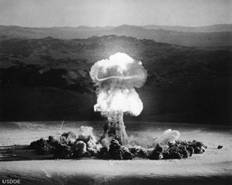|
Nuclear Bomb Information |





|
What are nuclear weapons? A nuclear weapon is an explosive device that derives its destructive force from nuclear reactions, either fission or a combination of fission and fusion. Both reactions release vast quantities of energy from relatively small amounts of matter; a modern thermonuclear weapon weighing little more than a thousand kilograms can produce an explosion comparable to the detonation of more than a billion kilograms of conventional high explosive. Manufacturing Nuclear weapon designs are physical, chemical, and engineering arrangements that cause the physics package of a nuclear weapon to detonate. There are three basic design types. In all three, the explosive energy is derived primarily from nuclear fission, not fusion. Pure fission weapons were the first nuclear weapons built and have so far been the only type ever used in warfare. The active material is fissile uranium (U-235) or plutonium (Pu-239), explosively assembled into a chain-reacting critical mass by one of two methods: Gun assembly, in which one piece of fissile uranium is fired at a fissile uranium target at the end of the weapon, similar to firing a bullet down a gun barrel (plutonium can be used in this design, but it has proven to be impractical), or implosion, in which a fissile mass of either material (U-235, Pu-239, or a combination) is surrounded by high explosives that compress the mass, resulting in criticality. Two-stage thermonuclear weapons are essentially a daisy chain of fusion-boosted fission weapons, with only two stages, in the chain. The second stage is imploded by x-ray energy from the first stage. This radiation implosion is much more effective than the high-explosive implosion of the primary. Consequently, the secondary can be many times more powerful than the primary, without being bigger. The secondary could be designed to maximize fusion energy release, but in most designs fusion is employed only to drive or enhance fission, as it is in the primary. More stages could be added, but the result would be a multi-megaton weapon too powerful to be useful. Facts: -Nuclear weapons include fission and fusion -Conventional weapons typically have a destructive capability measurable in the release of some number of tons of TNT -Fusion (‘hydrogen’ or ‘thermonuclear’) bombs, have the destructiveness of up to some millions of tons of TNT (megatons, mt). -The new millennium begins with 32,000 nuclear bombs possessed by eight nations containing 5,000 megatons of destructive energy. This is a global arsenal more than sufficient to destroy the world. -The Royal Swedish Academy of Science in 1982 concluded that a thermonuclear war using approximately 5,000 megatons [of nuclear weapons] would destroy all major cities of 500,000 population or greater in the United States, Canada, Europe, the USSR, Japan, China, India, Pakistan, Korea, Vietnam, Australia, South Africa, and Cuba. -a war involving as few as 100 megatons could trigger a nuclear winter. This would involve, say, hitting one hundred cities with 1-megaton warheads. This would induce such a drop in global temperatures and reduction of light that the resulting starvation and weather extremes would conceivably reduce the population of the planet to prehistoric levels. By this measure, we had then the ability to destroy the world 148 times in 1985 and 50 times over today. Users -Nuclear-Weapon States: China, France, Russia, United Kingdom, United States. Each of these five states originally declared its nuclear-weapons program and was recognized under the 1968 Nuclear Non-Proliferation Treaty (NPT) as a nuclear weapon state because it had tested a nuclear weapon prior to January 1, 1967. Estimated total nuclear warhead stockpiles: United States, 12,070; Russia, 22,500; United Kingdom, 260; France, 450; China, 400. |
|
Analysing the social and ethical implications of military development |
|
Military Technology Out of Control? |

